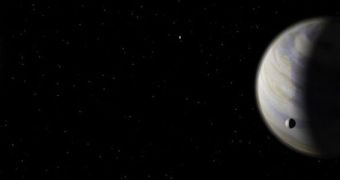University of Paris astronomers recently finished conducting a 3D simulation of the atmosphere surrounding the exoplanet Gliese 581d, which was determined to be potentially habitable in past investigations. The previous work was carried out by the same team.
The extrasolar plant is located in a star system surrounding the star Gliese 581. The entire system is very interesting to experts, since it contains several exoplanets with interesting characteristics.
In the first study the UP team conducted on Gliese 581d, experts only looked at a vertical column of the hypothetical atmosphere surrounding the planet. The column was sampled from the planet's day side.
Due to the close proximity to its parent star, the planet is tidally locked, which means that it always keeps the same face oriented towards the star. Similarly, the Moon is tidally locked to the Earth.
Classified as a super-Earth, Gliese 581d lies at the edge of its star's habitable zone, the area where temperatures are just right to support the existence of liquid water. But the results the team obtained during the last study were not conclusive, due to their limited nature.
In order to expand their understanding of the planet's atmosphere, UP investigators carried out a 3D simulation of the atmosphere, which provided them with new insight on the object's habitability.
The primary conclusion was that temperatures on the planet's night side are too low to allow for the existence of gaseous carbon dioxide (CO2) and water (H2O). What this means is that the chemicals would turn into crystals, and fall to the surface due to the cold.
Given that there is no heat source available to put them back into the air, the atmosphere is deprived of elements that would produce a greenhouse gas effect. This causes an atmospheric collapse, experts say.
In the simulations, the team used varying atmospheric pressures and compositions, and determined that some cases support a viable atmosphere, whereas others lead to its collapse. In some instances, CO2 clouds were found to form in the upper atmosphere, leading to a 12 degree Celsius temperature increase.
Some cases the team studied included the presence of an ocean of liquid water on Gliese 581d's surface. Such a feature would contribute to moderating the climate through H2O evaporation.
If the planet's atmosphere has a pressure higher than 20 bars, then water vapors from the oceans would be trapped in sufficient amounts to allow for global warming, and a potentially habitable world.
All the results the team got are speculative up to this point. However, they say that future generations of infrared instruments may be able to detect the light reflected by the exoplanet directly.
Gliese 581d is located a mere 20 light-years away from Earth, Universe Today reports.

 14 DAY TRIAL //
14 DAY TRIAL //